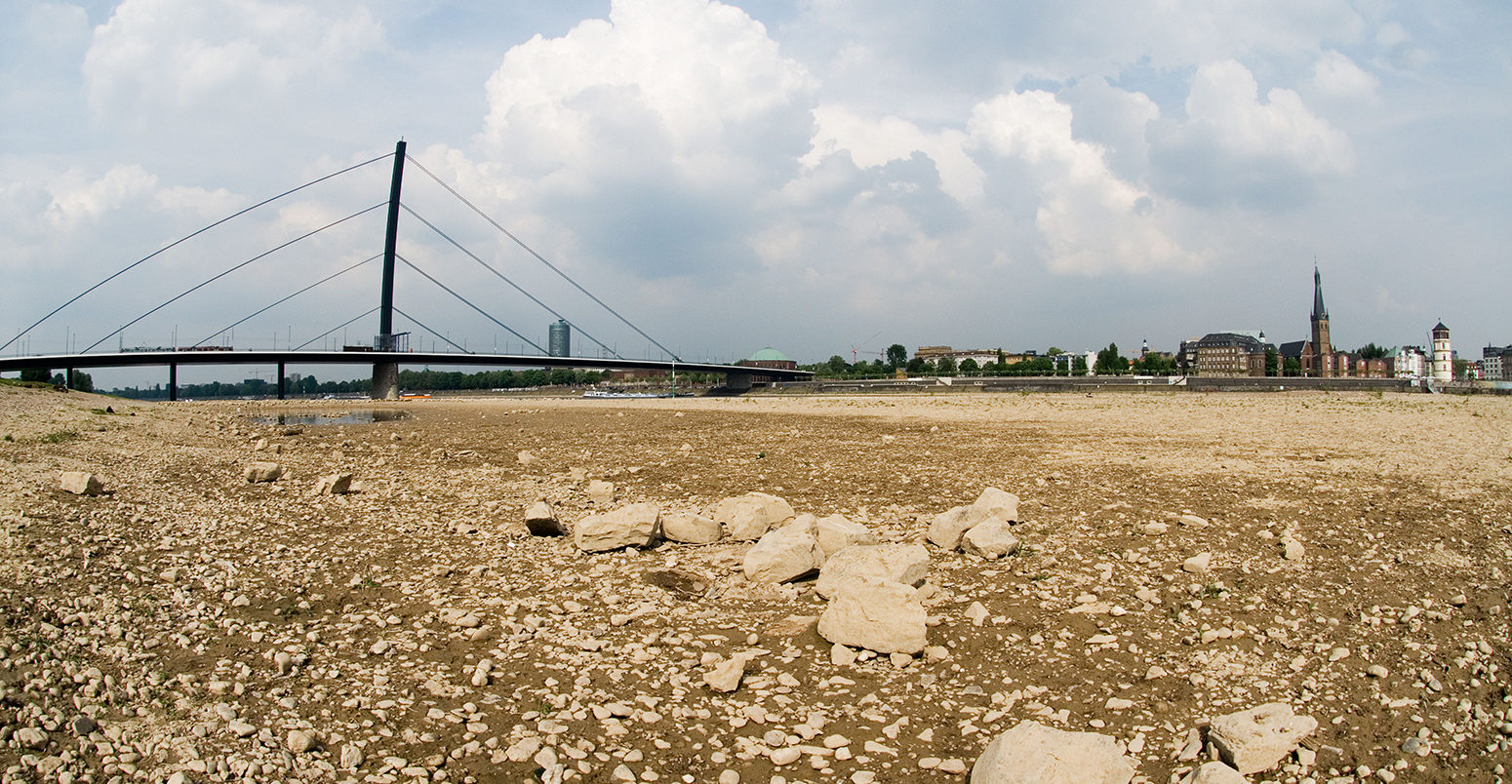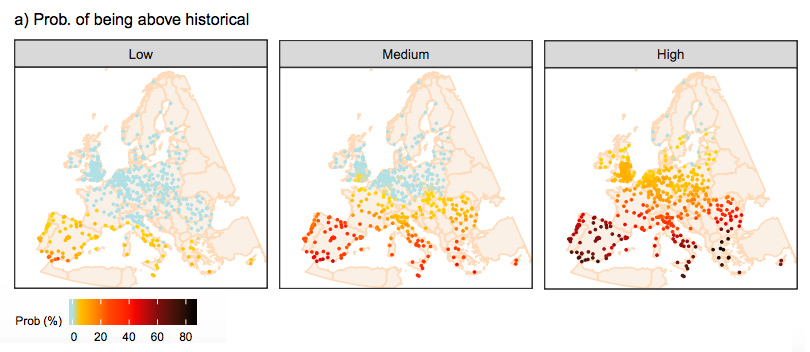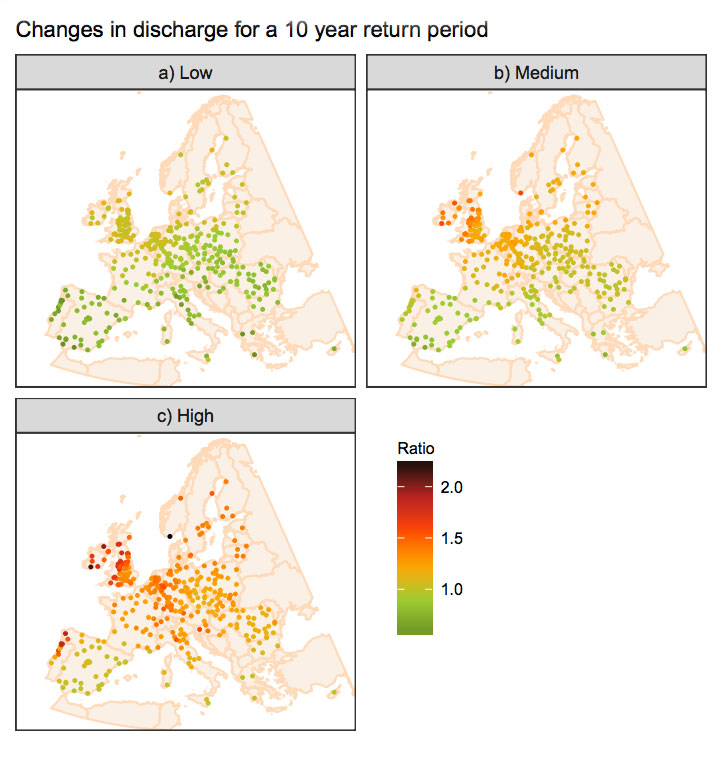
Climate change could cause more severe droughts in ‘98% of European cities’
Daisy Dunne
02.21.18Daisy Dunne
21.02.2018 | 12:32pmMore than 500 European cities could face sharp increases in droughts, floods and heatwaves if climate change continues to rise unabated, a new study finds.
The UK and Ireland could experience the largest rise in urban flood risk out of any region in Europe, the research shows, while the greatest heatwave temperature increases could be felt in Austria and Germany.
The findings also show that more than 100 cities could face a rise in the risk of two or more types of extreme event by the second half of the century, with Leeds, Cardiff and Exeter featuring in the top 20% of cities at risk of both heatwave and flooding increases.
The study is “an example of what might happen if we don’t start cutting our carbon emissions in a timely fashion”, a scientist not involved in the study tells Carbon Brief.
City concerns
More than 75% of the European Union’s population live in urban areas and this figure is expected to rise to 82% by 2050.
The new study, published in Environmental Research Letters, estimates how climate change could affect the risk of flooding, drought and heatwaves in 571 European cities by the second half of the century.
For the study, the researchers used a collection of climate models to simultaneously assess the risk of floods, droughts and heatwaves for every city.
Using a high-emission pathway known as RCP8.5, the models produced “low”, “medium” and “high” impact scenarios for each location.
The researchers estimated changes in risk by comparing the likelihood of extreme events from 1951-2000 to a future period of 2051-2100.
The research shows that every European city will face an increase in extreme weather event risk as the climate warms, says lead author Dr Selma Guerreiro, a researcher in hydrology and climate change from the University of Newcastle. She tells Carbon Brief:
“The British Isles have some of the worst overall flood projections. Southern European cities will see the biggest increases in the number of heatwave days. However, the greatest heatwave temperature increases are expected in central European cities.”
Heating up
Global warming is expected to cause an increase in the number of people exposed to heatwaves in the coming centuries.
The new research defines heatwaves as three consecutive nights where temperatures are in the top 5% of the 1951-2000 average for each city.
The maps below show how the proportion of heatwave days in the summer (top) and maximum temperature (bottom) of heatwaves could change in European cities under a low, medium and high-impact scenario. On the maps, each dot shows the results for one city – with impacts ranging from small (green) to large (dark red) increases.

Change in the proportion of heatwave days in the summer (left) and maximum heatwave temperature (right) in European cities in 2051-2100 compared to 1951-2000 under a low (left), medium (middle) and high (right) scenario. Source: Guerreiro et al. (2018)
The research finds that both the number and maximum temperature of heatwaves is likely to increase for every city under all of the scenarios.
Cities in southern Europe are expected to see the greatest increase in the number of heatwave days per year, with Lefkosia and Lemesos in Cyprus facing a 69% in heatwave days by 2050 under the high scenario.
Meanwhile, the largest increases in maximum heatwave temperature are expected to occur in central European cities, with some areas experiencing a rise of 14C above previous maximum temperatures. Under the high scenario, 72% of European cities could see an increase in maximum heatwave temperature by 2050.
Projections under the high scenario also suggest that cities in the UK could face maximum heatwave temperature increases of up to 12C as the climate warms, says Guerreiro:
“The UK is less affected than most of continental Europe for the low-impact scenario, where UK cities can expect changes in maximum temperature during a heatwave between 2C and 5C. However, for the high-impact scenario the maximum temperature during a heat-wave for UK cities could increase from 7C to 12C.”
Drying out
Changing rainfall patterns as a result of climate change is expected to lead to more droughts in some parts of Europe.
For the study, the researchers used a measure known as the drought severity index (DSI), which gives a picture of drought risk over a one-year period.
The charts below show the probability of drought risk for each city in 2050, when compared to risk from 1951-2000. On the maps, light blue indicates no change, while yellow shows a small increase and dark red shows a high increase.

Probability of drought risk in European cities in 2051-2100, compared to risk from 1951-2000. Light blue indicates no change, while yellow shows a small increase and dark red shows a high increase. Source: Guerreiro et al. (2018)
The findings show that the largest increases in drought risk are expected to affect southern European cities, including Lisbon and Faro in Portugal and Seville and Barcelona in Spain, says Guerreiro:
“For the low-impact scenario, cities in the south of Iberia, such as Malaga and Almeria, are expected to experience droughts that are more than twice as bad as today. While for the high impact scenario, 98% of European cities could see worse droughts in the future.”
The research also shows that, under the high-impact scenario, 21 cities in southern Europe may experience droughts that are up to 14 times worse than the extreme droughts of 1951-2000.
Spilling over
Climate change is expected to cause an increase in flood risk in much of Europe, although the scale of this impact is likely to affected by a range of factors, such as urban planning.
To understand changes in flood risk, the researchers estimated changes to maximum river flow (or “discharge”) over a ten-year return period for each city.
This shown on the chart below, where green shows a small increase in river flows and dark red shows a large increase.

Changes in river flow (discharge) over a ten-year return period in European cities in 2051-2100, compared to 1951-2000. Green shows a small increase in flood risk and dark red shows a large increase in flood risk. Source: Guerreiro et al. (2018)
The findings show that cities in the UK and Ireland could face the largest increase in river flows out of any region in Europe, with Glasgow, Wrexham, and Aberdeen being among the most at-risk cities.
Under the low scenario, 85% of UK cities could face increased river flooding, says Guerreiro:
“The British Isles are a future hotspot for river flooding in Europe. The cities predicted to be worst hit under the high-impact scenario for the British Isles are Cork, Derry, Waterford, Wrexham, Carlisle, and Glasgow. For the low-impact scenario, Derry, Chester, Carlisle, Aberdeen, and Glasgow could be worst affected.”
‘Substantial challenge’
The findings also show that more than 100 cities in Europe could face a rise in the risk of two or more types of extreme event by the second half of the century.
In the UK, Cardiff, Exeter, Leeds and Newport fall within the top 20% of European cities at risk of both heatwave and flooding increases as the climate warms, Guerreiro says:
“We hope to highlight the substantial challenge cities face in managing climate risks and provide an encompassing view of possible future changes in climate.”
The new research advances our understanding of extreme weather risks in European cities by “considering all these hazards together,” says Dr Dann Mitchell, a researcher in climate change, extreme events and human health at the University of Bristol, who was not involved in the study.
However, it is worth bearing in mind that the research uses a high emissions trajectory for its analysis, he tells Carbon Brief:
“It would also be interesting to see how sensitive their analysis is to other greenhouse gas emissions. The emission scenario used in their study is much higher than that which would be consistent with the Paris Agreement and so their study could be thought of as an example of what might happen if we don’t start cutting our carbon emissions in a timely fashion.”
Guerreiro, S. B. et al. (2018), Future heat-waves, droughts and floods in 571 European cities, http://iopscience.iop.org/article/10.1088/1748-9326/aaaad3/meta
-
Climate change could cause more severe droughts in ‘98% of European cities’

